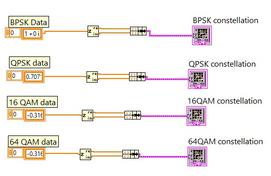
FSK Modulation Implementation in Python
This article provides Python code for Frequency Shift Keying (FSK) modulation, generating an FSK modulated waveform from binary data.
Showing 20 posts (Page 4 of 8)
Advertisement

This article provides Python code for Frequency Shift Keying (FSK) modulation, generating an FSK modulated waveform from binary data.

Explore FSK modulation with MATLAB code, explanation of principles, and input/output examples. Learn how to implement FSK.

Explore the pros and cons of FSK modulation, covering its noise immunity and implementation simplicity, as well as bandwidth and power efficiency limitations.
Explore the benefits and drawbacks of GFSK modulation, including its spectral efficiency, bandwidth usage, and limitations in noise sensitivity and constant envelope applications.

Explore the differences between GFSK and FSK modulation techniques, focusing on spectral efficiency and applications like Bluetooth.

Explore the key differences between GFSK and GMSK modulation techniques, their applications, and advantages in wireless communication systems.
MATLAB source code for GMSK modulation, a technique used in wireless systems to achieve continuous phase shift.

Explore the GSM physical layer (layer-1) functions, including baseband processing, FEC, ciphering, burst formation, and modulation for mobile station transmission.
Explore hybrid OFDM modulation techniques, including MC/DS-CDMA, MC-CDMA, and OFCDM. Learn how they combine the advantages of OFDM and CDMA for improved performance.

Explore IBOC technology, which delivers CD-quality audio and data services over existing FM channels using hybrid, extended hybrid, and all-digital modes.

Explore IQ imbalance (gain, phase, DC offset), its impact on constellation diagrams, and compensation methods in communication systems.

Explore IQ mixers, crucial components in RF and communication systems. Learn about their operation, key features, specifications, and leading manufacturers.

LabVIEW VI examples for generating constellation diagrams for BPSK, QPSK, 16QAM, and 64QAM modulation techniques.

LabVIEW source code for modulators and demodulators implementing BPSK, QPSK, 16QAM, and 64QAM modulation techniques. Download links provided.

Explore the LiFi physical layer (PHY), including PHY-I, PHY-II, and PHY-III versions, their features, modulation, and code rates for different data rate needs.

Explore LoRa modulation, also known as CSS, its advantages, properties, and how it simplifies receiver design. Understand the relationship between bit rate, chip rate, and symbol rate.

Calculate LTE code rates based on MCS, PRBs, and OFDM symbols. Includes formulas and tables for accurate calculations.

Learn about the LTE PCH (Paging Channel), including the physical layer processing steps for the transmitter, such as CRC, channel coding, and modulation.

Understand the LTE PUSCH channel, its role in carrying RRC signaling, UCI, application data, and its modulation schemes like QPSK, 16QAM and 64QAM.

Explore the pros and cons of MFSK (Multiple Frequency Shift Keying), including benefits like reduced error rates and drawbacks like complex tuning.
Advertisement